Research News
75 news
-
2025-10-14
Research News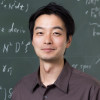
RIKEN Research: Looking at black-hole oscillations through a mathematical lens
By applying a versatile mathematical technique to black holes, RIKEN cosmologists have uncovered new subtleties about how they vibrate. Black holes are some of the most intriguing objects in the Universe. Their gravitational pull is so strong that not even light can escape from their surfaces. Astronomers can only observe light produced indirectly by material falling into black holes. Since 2016, they have had another means of investigating black holes—gravitational waves. These are ripples created in the fabric of space–time through cataclysmic events such as the merger of two black holes. Immediately after merging, special oscillations known as quasi-normal modes are set up in the resulting black hole. “Quasi-normal modes are frequency modes that are generated when a black hole experiences some major disturbance,” explains Ryo Namba of the RIKEN Center for Interdisciplinary Theoretical and Mathematical Sciences. These vibrations emit gravitational waves after a merger. While the higher overtones of quasi-normal modes of such gravitational waves are too weak for today’s detectors, astrophysicists can study quasi-normal modes mathematically. To read more, please visit the related link.
-
2025-07-17
Research News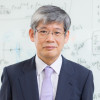
RIKEN NEWS: Interview with the Executive Director of Science — Unlocking the Future through the Synergy of Mathematical, Computational, and Information Sciences
An interview with Tetsuo Hatsuda (Executive Director of Science, RIKEN / Director, the Division of Applied Mathematical Science, RIKEN iTHEMS) has been featured in the Close-up RIKEN 2025 series on RIKEN’s research introduction page. To leverage RIKEN’s strength in integrated research capabilities and to ensure more strategic and effective operations, RIKEN introduced a new structure in FY2025 consisting of five “Research Domains.” Each domain is headed by an Executive Director of Science—a scientist with internationally recognized excellence and profound insight into both academic research and its administration. This system is designed to promote interdisciplinary collaboration rooted in advanced expertise, thereby accelerating the creation of new knowledge. Supporting the Executive Directors of Science in driving research forward are the Promotion Directors. This interview explores the aims of the Mathematical, Computational, and Information Sciences Domain from the perspectives of both researchers and administrative staff. Please see the related links for the full article.
-
2025-07-08
Research News
RIKEN NEWS: The Appeal of the ECL Program in Nurturing Early-Career Researchers
An interview with Leo Speidel (RIKEN ECL Research Unit Leader, Mathematical Genomics RIKEN ECL Research Unit) has been featured in the Topics section, as part of the Close-up RIKEN 2025 series on RIKEN’s research introduction page. A video interview is also available alongside the article. The RIKEN Early Career Leaders (ECL) Program was launched in 2023 to provide more substantial support for early-career researchers. Building on and expanding the previous RIKEN Hakubi Program, the ECL Program enables researchers to pursue agile and flexible research. In addition to appointing Team Leaders (equivalent to department heads or young professors at universities), the program has introduced the position of Unit Leader (equivalent to section heads or associate professors/lecturers at universities) to support outstanding young researchers with limited experience. These Unit Leaders are provided with a highly mobile and independent research environment at their host research centers. We spoke with Dr. Leo Speidel, the RIKEN ECL Research Unit Leader of the Mathematical Genomics RIKEN ECL Research Unit, Mathematical Science Core Division, at the Interdisciplinary Theoretical and Mathematical Sciences Program (iTHEMS), who is part of the program's first cohort. He is working to uncover human evolution and history through the study of DNA mutations, and he shared with us the appeal of the ECL Program. For more information, please see the related links below.
-
2025-06-23
Research News
RIKEN NEWS: A New World Unlocked by a Data Geek
An interview with Catherine Beauchemin (Deputy Director, iTHEMS) has been featured in the RIKEN People section, as part of the Close-up RIKEN 2025 series on RIKEN’s research introduction page. With her quick wit, rapid-fire speech, and warm smile, she embodies the charm and potential of what it means to be human. Dr. Beauchemin is pioneering a new research field known as “virus physics.” By applying the tools of physics, she investigates viruses, unseen entities that can pose serious threats to our lives. To read the full story, please see the related link below.
-
2025-04-14
Research News
RIKEN Research: When it comes to modeling, even unmeasurable data tells us something
Mathematical models for predicting how cancer tumors in mice grow over time can give distorted results if unmeasurable data is ignored, a team that includes two RIKEN researchers has shown1. This finding has important implications when applying mathematical models to medicine. A self-confessed data geek, Catherine Beauchemin of the RIKEN Center for Interdisciplinary Theoretical and Mathematical Sciences (iTHEMS) specializes in applying the power of math to everything from viruses to supernovae. “I love trying to figure out what data are telling us,” she says. Seeking new insights into cancer mechanisms, Beauchemin’s team used mathematical models to analyze previously published data of tumor-size measurements over time for ten mice. To read more, please visit the related link.
-
2025-04-14
Research News
RIKEN Research: Refined test could improve Parkinson’s disease diagnosis
A team that includes a RIKEN researcher has refined a lab test for measuring protein aggregate levels in samples from patients with certain neurodegenerative diseases1. This has the potential to improve diagnosis and drug development for these diseases. Synucleinopathies are neurodegenerative diseases such as Parkinson’s disease and dementia with Lewy bodies. They are associated with the accumulation of aggregates of misfolded alpha-synuclein proteins in the brain and spinal cord. “When a misfolded alpha-synuclein protein in a neuron encounters one of its properly folded counterparts, it causes it to become misfolded,” says Catherine Beauchemin of the RIKEN Center for Interdisciplinary Theoretical and Mathematical Sciences. “The two misfolded alpha-synuclein proteins stick together and cause other normal alpha-synuclein to misfold and aggregate.” To read more, please visit the related link.
-
2025-04-14
Research News
RIKEN NEWS: Exploring Critical Magnetic Transport Phenomena with a Quantum Simulator
An interview with Yuta Sekino (Postdoctoral Researcher, iTHEMS) has been featured in Research Highlights, part of the "Close-up RIKEN 2025" series on RIKEN’s research introduction page. It has also been published in SPRING 2025 issue of RIKEN’s public relations magazine, RIKEN NEWS. Postdoctoral Researcher Yuta Sekino is theoretically investigating the behavior of "many-particle systems," which are collections of particles. He devised a new model that captures the flow of magnetism by confining individual atoms in an ultrafine lattice (optical lattice) created with lasers. Through theoretical calculations based on this model, he discovered a mysterious magnetic transport phenomenon. For more details, please see the related link.
-
2025-04-08
Research News
RIKEN NEWS: Unraveling the Evolutionary Mechanisms of Cooperative Behavior Using Fugaku
An interview article with Yohsuke Murase (Senior Research Scientist) has been featured in Research Highlights, part of the "Close-up RIKEN 2025" series on RIKEN’s research introduction page. It has also been published in SPRING 2025 issue of RIKEN’s public relations magazine, RIKEN NEWS. We humans, often described as social animals, engage in "cooperative behavior"—working together and helping one another. Focusing on the key role played by "reputation," Dr. Yohsuke Murase and an international research team analyzed the dynamics of this information using the supercomputer Fugaku. Their findings revealed the evolutionary path of humanity, shaped by cooperative behavior. For more details, please refer to the related links.
-
2025-03-06
Research News
Review on Physics-Driven Learning for Inverse Problems Published in Nature Reviews Physics
Nature Reviews Physics recently published a review paper on ”Physics-driven learning for inverse problems in quantum chromodynamics”, from DEEP-IN working group led by Lingxiao Wang (Research Scientist, iTHEMS), including Tetsuo Hatsuda (Program Director, iTHEMS). The authors explore how combining deep learning techniques with physics-driven designs significantly improves the extraction of accurate physical properties from complex QCD phenomena. Highlighting applications such as lattice QCD calculations and studies of hadron interactions, neutron stars, and heavy-ion collisions, the review emphasizes the benefits of embedding physical priors into machine learning models and suggests broader potentials to general physics problems.
-
2024-09-10
Research News
RIKEN Research: More magic in twisted layers of graphene
Magnetic fields can engineer flat bands in twisted graphene layers to create a new playground for exotic physics, RIKEN physicists have shown. The exotic properties of graphene—a single layer of carbon atoms in a hexagonal lattice—are now well established. Electrons effectively move through graphene as if they have no mass. This is an exciting prospect for creating electronic devices with functionalities beyond those of silicon. But things get even weirder when two or more layers of graphene are combined. To read more, please visit the related link.
-
2024-09-02
Research News
RIKEN Research: The link between fuzzy images and quantum fields
Mathematical solutions to thorny quantum problems can be found more quickly by exploiting the correspondence between the statistical methods used in deep learning and techniques for implementing quantum simulations, a team led by a RIKEN researcher has shown. One of the most successful theories in modern physics, quantum field theory is physicists’ attempt to combine three theories—classical field physics, Einstein’s special relativity and quantum mechanics—into a single mathematical model. It has been successful in solving problems in particle physics and condensed-matter physics, but these calculations are computationally intensive and require a lot of computer power. To read more, please visit the related link.
-
2024-07-24
Research NewsThe annual S&T poster for everyone “One S&T poster for Every Household” produced by the MEXT celebrates its 20th anniversary with a special issue
To commemorate the 20th anniversary this year of the annual S&T poster for everyone “One S&T poster for Every Household” published by the Ministry of Education, Culture, Sports, Science and Technology (MEXT) during Science and Technology Week in April every year, a PDF version of the Science Window ‘One S&T poster for Every Household 20th Anniversary Special Issue’ was published in June. You can read all pages from the first one, ‘Periodic Table of Elements’, to the 20th, ‘Mathematics’, as well as columns on three themes: the Periodic Table of Elements, the Human Genome Map and Mathematics. The printed booklet is expected to be completed in autumn.
-
2024-03-29
Research News
RIKEN Research: How the genetic battle of the sexes plays out in species that can switch sex
A model developed by RIKEN researchers incorporates species that change sex during their life cycles for the first time1, promising new insights into genes affecting the reproductive success of males and females differently. Some genes that boost the reproductive success of females can be detrimental to that of males, and vice versa—a phenomenon dubbed ‘sexual antagonism’. Sometimes such genes can be silenced in individuals of the sex they are detrimental to. However, it may take a long time for these sexually antagonistic genes to be turned off, and so they may remain active in both sexes for generations. “Researchers have long been interested in how sexual antagonism may maintain genetic variation in populations, and whether variants favoring one sex are systematically preferred,” says Thomas Hitchcock of the RIKEN Interdisciplinary Theoretical and Mathematical Sciences. To read more, please visit the related link.
-
2023-06-12
Research News
RIKEN NEWS: Unraveling the Puzzle of Complex Ecosystems with Mathematical Models
Ryosuke Iritani (Senior Research Scientist, iTHEMS) is interviewed on the RIKEN website. Nature is home to a multitude of ecosystems, each teeming with a rich variety of organisms. Within these intricate webs of life, diverse species interact and adapt, giving rise to complex and fascinating structures. However, comprehending the inner workings of these ecosystems poses a significant challenge, owing to their inherent complexity. At RIKEN, a team of dedicated researchers is harnessing the power of mathematical models to elucidate the intricacies of ecosystems and unlock their enigmatic nature. To shed light on this endeavor, we turn to Ryosuke Iritani, who graciously provides us with insights into their ongoing work. To read more, please visit the related link.
-
2023-04-24
Research News
RIKEN Research: Quantum ‘magic’ could help explain the origin of spacetime
A quantum property dubbed ‘magic’ could be the key to explaining how space and time emerged, a new mathematical analysis by three RIKEN physicists suggests. It’s hard to conceive of anything more basic than the fabric of spacetime that underpins the Universe, but theoretical physicists have been questioning this assumption. “Physicists have long been fascinated about the possibility that space and time are not fundamental, but rather are derived from something deeper,” says Kanato Goto of the RIKEN Interdisciplinary Theoretical and Mathematical Sciences (iTHEMS). To read more, please visit the related link.
-
2023-04-17
Research News
RIKEN Research: Gravitational waves could indicate transition to strange quark matter
Telltale signatures in gravitational-wave signals from merging neutron stars should reveal what happens to matter at the extreme pressures generated during such mergers, calculations by RIKEN researchers predict [1]. If you took some water and compressed it with a piston, it would shrink as the molecules get pushed closer together. If you continued ramping up the pressure, you’d reach a point where the atoms collapse and form an ultra-dense soup of neutrons and protons. The only place in the Universe where this happens is neutron stars, the collapsed remnants of burned-out stars, and it produces mind-boggling densities—one teaspoon of such material weighs several hundred billion kilograms. But what would happen if you continued to increase the pressure still further? Not even astrophysicists know the answer to that. To read more, please visit the related link.
-
2023-03-15
Research News
RIKEN NEWS: Interview with Special Postdoctoral Researcher (2): A great first step as a mathematician at the age of 38
Taketo Sano (Special Postdoctoral Researcher, iTHEMS) is interviewed on the RIKEN website. RIKEN has a Special Postdoctoral Researchers Program, which allows young researchers to work independently on a research theme of their own choice and free thinking, with the aim of fostering researchers who will be active internationally. We took this opportunity to interview senior researchers and current researchers who are active in their respective fields. In this second installment, we interview Taketo Sano, a Special Postdoctoral Researcher, iTHEMS. To read more, please see the related link.
-
2023-03-13
Research News
RIKEN Research: Explanation found for puzzling observation of Shiba states in superconductors
The origin of a mysterious experimental observation in a superconductor with a magnetic impurity sitting on top of it has been revealed in a theoretical study by a RIKEN researcher and a collaborator. This could help realize a robust quantum state residing in a superconductor that may find application in quantum computers. Superconductors conduct electricity without any resistance because electrons in them form pairs that have an energy gap. But placing a magnetic atom on top of a superconductor creates a new state in this energy gap as a result of the atom’s magnetism interacting with the superconductor’s paired electrons. Known as the Yu–Shiba–Rusinov state, or Shiba state for short, this state has been attracting a lot of interest because it could shed light on the emergence of a special state in a topological superconductor called the Majorana zero mode, which is promising for realizing fault-tolerant quantum computing. To read more, please visit the related link.
-
2023-01-04
Research News
RIKEN NEWS: The Power of Open Science to Defeat Pandemics
Catherine Beauchemin (Deputy Program Director, iTHEMS) is interviewed in the Winter issue of RIKEN NEWS 2023. COVID-19 can only transmit if an infected person infects an uninfected person. So if 100% of sick people stayed home, there would be zero new cases, and COVID-19 would be over. Since transmission relies on the behaviour of each individual, to manage or even end COVID-19 requires the cooperation of every person in society. This is the big challenge we continue to face even now. Misinformation has become a big problem in society. People trust their own opinion and that of their friends and family more than facts. There is also a tendency to distrust government officials, pharmaceutical companies, news media and scientists. Sometimes it is true that such people or organizations will lie or exaggerate, so it is reasonable and important for a person to be skeptical. In fact, skeptical thinking is essential in science: we need to open our mind to new results, especially those that contradict our assumptions and hypotheses. So what can be done? I think the best way to combat misinformation and build a lasting trust with the public is complete transparency, by openly (free/re-usable) sharing data and scientific analyses with the general public, so people around the world can independently verify the facts. To read more, please see the related link.
-
2022-08-26
Research News
RIKEN Research: Applying quantum speed limits to macroscopic systems
An expression for the maximum speed at which changes in macroscopic systems can occur has been derived by a theoretical physicist at RIKEN. This will deepen our understanding of quantum phenomena in systems that are not in equilibrium. One of the hardest aspects of quantum mechanics to grasp is the Heisenberg uncertainty principle that states that it is not possible to simultaneously pin down both the position and momentum of an object. In other words, the more precisely a particle’s position is determined, the broader the range of its possible momentum becomes (and vice versa). In 1945, two physicists, Leonid Mandelstam and Igor Tamm, focused on another type of the uncertainty relation, namely one between time and energy fluctuation, and showed that transitions in quantum systems don’t happen instantaneously; rather, the speed at which a transition occurs is capped by an amount determined by how much the energy of the system fluctuates. Many other so-called quantum speed limits have subsequently been derived, which have helped better understand the physics of quantum systems and have been useful in various quantum applications. But big problems arise when quantum speed limits are applied to macroscopic systems. “Previous quantum speed limits, which are useful for small systems, typically become meaningless for macroscopic transitions,” notes Ryusuke Hamazaki of the Nonequilibrium Quantum Statistical Mechanics RIKEN Hakubi Research Team. “For example, conventional quantum speed limits give an infinite upper bound for the speed of transitions in a gas made up of atoms.” To read more, please visit the related link.
-
2022-07-21
Research News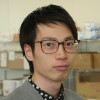
RIKEN NEWS: Collective Motion in Atomic World
It is mysterious to see a large flock of starlings or sardines change its direction simultaneously and collectively. Similar phenomena have been observed in smaller systems like cells in our body. Using computer simulations, Dr. Kyosuke Adachi (Special Postdoctoral Researcher) has theoretically found that such collective behavior can occur in the even smaller atomic world. To read more, please visit the related link.
-
2022-06-28
Research News
RIKEN Research: Flitting between the wings of a butterfly
Just making small tweaks to certain variables could potentially modify extreme weather events such as sudden downpours, computer simula- tions by two RIKEN researchers have shown. Scientists have long desired to develop ways to control the weather. Research in this area has intensified due to climate change, which is giving rise to more extreme weather events. Present methods for modifying the weather have limited success. Seeding the atmosphere can induce rain, but only when the atmosphere is already in a state where it might rain. Geoen- gineering projects have been envisioned, but they have yet to be conducted due to concerns about unpredicted long-term effects. As a promising approach, Takemasa Miyoshi and Qiwen Sun, both of the RIKEN Center for Computational Science, have looked to chaos theory to assess the possibility of mitigating weather events such as torrential rain by making small changes. Instead of con- sidering the weather system in all its complexity, they focused on a far simpler system—the butterfly attractor. To read more, please see related links.
-
2022-06-28
Research News
RIKEN Research: Worming out of the black-hole information paradox
RIKEN physicist and two colleagues have found that a wormhole—a theoretical bridge connecting distant regions of the Universe—may help to shed light on the mystery of what happens to information about matter consumed by black holes. Einstein’s theory of general relativity predicts that nothing that falls into a black hole can escape its clutches. But in the 1970s, Stephen Hawking calculated that black holes should emit radiation when quantum mechanics, the theory governing the microscopic realm, is considered. “This is called black hole evaporation because the black hole shrinks, just like an evaporating water droplet,” explains Kanato Goto of the RIKEN Interdisciplinary Theoretical and Mathematical Sciences. To read more, please see related links.
-
2022-04-25
Research News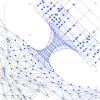
RIKEN Research: Quantum computing and deep learning could help solve the mysteries of quantum gravity
RIKEN physicists have put quantum computing and deep learning through their paces and found that they are powerful tools for gleaning insights into new theories of quantum gravity [1]. They could thus help solve one of the most formidable challenges in modern physics—developing a theory of gravity that jives with quantum physics. When Einstein nutted out his theory of general relativity in 1915, his only tools were pen and paper. The same was true of the pioneers of quantum theory. But the next major breakthrough in theoretical physics could be made with help from emerging technologies such as quantum computers and machine learning, Enrico Rinaldi of RIKEN Theoretical Quantum Physics Laboratory thinks. “I believe these technologies are poised to transform the way we do theoretical physics,” he says. To read more, please visit the related link.
-
2022-04-08
Research News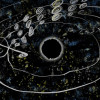
RIKEN Research: Ringing black holes could put general relativity to the test
Typical overtone chords in the gravitational waves produced when black holes collide could be used to test general relativity, a mathematical analysis by a RIKEN physicist has shown [1]. When black holes merge, they generate gravitational waves, which ripple outward like sound waves from a ringing bell. In theory, these gravitational waves can be broken down into tones and overtones—like in music—based on their different frequencies and the rate at which they dampen and die out. But in practice, gravitational-wave detectors are not yet sensitive enough to definitively pick up the overtones. However, cosmologists are keen to measure the precise oscillation pattern because it can tell them more about a black hole’s properties. In particular, the mass of the black hole and the rate at which it is spinning can be calculated from the damping rate and frequency. “It’s like when you hear an instrument, you can understand if it is a guitar or a piano,” says Naritaka Oshita of the RIKEN Interdisciplinary Theoretical and Mathematical Sciences Program (iTHEMS). To read more, please visit the related link.
-
2022-04-06
Research News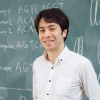
The Horse: Breeding Mares Early in Life Might Lead to Early Fertility Decline
Jeffrey Fawcett (Senior Research Scientist, iTHEMS) and his research was featured in an article in The Horse. If you want to breed an older mare, you might consider how old she was when she was first bred. According to a new study in Japanese racehorses, broodmare fertility appears to decrease slowly over the years, on a downhill slope that follows her number of breeding years—and not just her age. “Our results suggest that the fertility of a mare is the highest at (her) first year breeding and gradually declines every year,” said Jeffrey Fawcett, PhD, a biologist and senior research scientist at RIKEN Interdisciplinary Theoretical and Mathematical Sciences Program (iTHEMS), in Saitama, Japan. To read more, please visit the related link.
-
2022-04-06
Research News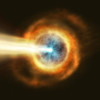
RIKEN Research: Thermal electrons play key role in determining emissions from gamma-ray-burst afterglows
he presence of unusually energetic gamma rays seen in some afterglows from intense gamma-ray bursts (GRBs) could be explained by a new mathematical model developed by RIKEN researchers1. This finding could help to shed light on the origin of GRBs. A GRB is a spectacular eruption of energy produced by violent events such as the explosive death of a massive star, or the collision of two neutron stars. A GRB also shoots a jet of matter and energy into the material that surrounded the star, shocking particles such as protons and electrons and causing them to emit radiation. The emitted photons, ranging from radio waves to gamma rays, can be detected from Earth as a GRB afterglow. The vast majority of GRB afterglow observations can be explained by current theories, which should come as no surprise: they wouldn’t be the current theories if they didn’t match reality. But the afterglows of two recent GRBs produced gamma rays with unusually high energies that strain these theories. “The surprise with these two bursts was that we had never detected photons this energetic before,” says Donald Warren of the RIKEN Interdisciplinary Theoretical and Mathematical Sciences Program (iTHEMS). To read more, please visit the related link.
-
2022-02-14
Research News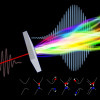
RIKEN Research: Modeling high-harmonic generation without resorting to perturbation theory
An advanced mathematical model that can describe high-energy interactions between light and matter has been developed by two RIKEN researchers and a collaborator [1]. The approach could be extended to offer new insights in other areas of physics. High-harmonic generation is a powerful technique that converts laser light from one wavelength, or color, to another. Put simply, it converts a low-energy, long-wavelength photon into multiple higher energy, shorter wavelength photons. High-harmonic generation has several applications. For example, it offers a way to create table-top sources of extreme ultraviolet or x-ray light using lasers, rather than expensive synchrotron facilities. High-harmonic generation can also produce ultrashort light pulses, as short as one attosecond ($10^{-18}$ second) or maybe even one zeptosecond ($10^{-21}$ second), which are useful for imaging extremely rapid processes such as those that occur in atoms. But high-harmonic generation is inherently difficult to model mathematically, and thus understand fully. Now, Hidetoshi Taya and Masaru Hongo from the RIKEN Interdisciplinary Theoretical and Mathematical Sciences (iTHEMS) Program, together with their colleague Tatsuhiko Ikeda from the University of Tokyo, have developed an analytical approach to high-harmonic generation in the so-called non-perturbative regime for the first time. To read more, please visit the related link.
-
2022-01-14
Research News
RIKEN NEWS: Uncovering the laws of evolution hidden in genomic information
Jeffrey Fawcett (Senior Research Scientist) is interviewed on the RIKEN website. Life on Earth has been around for about 4 billion years. Over the years, organisms have evolved into a wide variety of species. This is also the history of how the genomes have evolved. Jeffrey Fawcett (Senior Research Scientist, iTHEMS) is trying to unravel the mystery of how the differences between species arose by taking a mathematical science approach. To read more, please see the related link.
-
2021-12-13
Research News
RIKEN Research: Exotic six-quark particle predicted by supercomputers
Dr. Takuya Sugiura (Postdoctoral Researcher, iTHEMS) was featured in the Research News on the RIKEN website. The predicted existence of an exotic particle made up of six elementary particles known as quarks by RIKEN researchers could deepen our understanding of how quarks combine to form the nuclei of atoms. To read more, please see the related links.
-
2021-07-29
Research News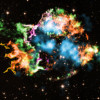
RIKEN Research: Smoking-gun evidence for neutrinos’ role in supernova explosions
Supernova explosions are sustained by neutrinos from neutron stars, a new observation suggests. Shigehiro Nagataki (Deputy Program Director, iTHEMS) were interviewed in the article.
-
2021-07-27
Research News
iTHEMS research activities and researchers were featured in "RIKEN 2021"
iTHEMS research activities and researchers were featured in several articles in "RIKEN 2021". p.8-9: A Theoretical Description of the Inside of an Evaporating Black Hole and a Closer Look at Its True Nature (Yuki Yokokura) p.10-11: Image only (Don Warren and Naomi Tsuji) p.20-21: Tackling the Mysteries of Biology with Mathematical Science Models (iTHEMS Biology Seminar Study Group)
-
2021-06-28
Research News
RIKEN Research: Physics modeling of viral spread between cells
Prof. Catherine Beauchemin (Deputy Program Director, iTHEMS) was featured in the summer issue of RIKEN RESEARCH 2021. Describe your role at RIKEN - I first joined RIKEN in 2016 as a senior visiting scientist at iTHES, the predecessor of the Interdisciplinary Theoretical and Mathematical Sciences (iTHEMS) program. In 2020, I became one of four iTHEMS deputy program directors. I am in a field I call ‘virophysics’; the application of physics methods to virology. Primarily, I construct computer and mathematical models to explain the experimental observations made when viruses infect cell cultures. In biology, such knowledge is usually advanced through experimental trial and error, but physics modeling can help streamline this process. To read more, please see the related links.
-
2021-06-25
Research News
RIKEN NEWS: What is the Significance of Basic Research?
Program Director Tetsuo Hatsuda is interviewed on the RIKEN website and summer issue of RIKEN NEWS 2021. How did the universe begin? Why does matter exist? What is the origin of life? Basic research, which pursues such fundamental questions, is difficult for the general public to understand because it does not necessarily lead to immediate practical applications. We asked Tetsuo Hatsuda, Program Director (PD) of the Theoretical and Mathematical Sciences Program (iTHEMS), what exactly basic research is. To read more, please see the related link (in Japanese).
-
2021-04-02
Research News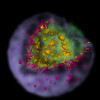
RIKEN Research: Supernova simulations reveal how stellar explosions shape debris clouds
Astronomers are now in a better position to interpret observations of supernova remnants thanks to computer simulations of these cataclysmic events by RIKEN astrophysicists.
-
2021-03-01
Research News
RIKEN Research: Supernova had a missing companion star
The massive star that exploded to form the supernova known as Cassiopeia A most likely had a companion star that has yet to be spotted, a spectro-scopic analysis by RIKEN astro-physicists suggests.
-
2021-03-01
Research News
RIKEN Research: RIKEN and JAXA collaborate on real-time rainfall forecasts
Researchers from RIKEN, Chiba Univer-sity, the University of Tokyo and the Japan Aerospace Exploration Agency (JAXA) have used a combination of satellite data and supercomputer simulations to offer five-day rainfall forecasts over the Internet covering the globe. Dr. Takemasa Miyoshi (iTHEMS/R-CCS) commented in the article.
-
2021-02-08
Research News
RIKEN NEWS: Tracking the Evolution of Matter in the Universe — From nuclei to atoms and molecules
A five-year project titled "Material Evolution in the Universe — Nuclei, Atoms, Molecules, and Beyond" is underway at RIKEN starting in 2019. The project is led by the Dr. Sakai at Star and Planet Formation Laboratory, the Dr. Tamagawa at High Energy Astrophysics Laboratory, and the Dr. Nagataki at Astrophysical Big Bang Laboratory, and brings together researchers from inside and outside RIKEN. The goal is to realize a new type of space research that integrates physics and chemistry, and to understand the evolution of matter from nuclei to atoms to molecules.
-
2021-01-13
Research News
RIKEN NEWS: Guerrilla Rainstorm forecast updated every 30 seconds
It has been a long time since guerrilla rains have become a social problem, threatening our daily lives with localized and sudden fierce rains that cause flooding and power outages. However, current weather forecasting technology is unable to predict the occurrence of guerrilla rainstorms. Team leader Tatemasa Miyoshi (TL) of the Data Assimilation Research Team at the RIKEN Center for Computational Science (R-CCS) has developed an innovative weather forecasting method that takes in and updates observation data every 30 seconds, and is trying to realize guerrilla rainfall forecasting.
-
2020-11-13
Research News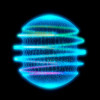
Dark-matter candidate could display stringy effects in the lab
-Calculations show how theoretical ‘axionic strings’ could create odd behavior if produced in exotic materials in the lab- A hypothetical particle that could solve one of the biggest puzzles in cosmology just got a little less mysterious. A RIKEN physicist and two colleagues have revealed the mathematical underpinnings that could explain how so-called axions might generate string-like entities that create a strange voltage in lab materials[1].
-
2020-09-07
Research News
RIKEN NEWS: To produce the best racehorse
The article written by Dr. Jeffrey Fawcett, Senior Research Scientist, was published in this month's RIKEN News. He wrote about the genetics of Thoroughbred horses and his research using genomic data of Japanese Thoroughbreds.
-
2020-09-02
Research News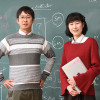
Dr. Nagisa Hiroshima and Dr. Yoshiyuki Inoue were highlighted in an article of RIKEN 2020 about Dark Matter Search
It is our great pleasure to inform you that our iTHEMS colleagues, Nagisa Hiroshima and Yoshiyuki Inoue, are highlighted in RIKEN Annual Report 2020 for their leading role in organizing the iTHEMS "Dark Matter Working Group". This working group aims at creating a new domestic and international network of theoretical and experimental physicists who are interested in dark matter search.
-
2020-06-26
Research News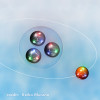
RIKEN Research: Light nucleus predicted to be stable despite having two strange quarks
Adding an exotic particle known as a Xi hyperon to a helium nucleus with three nucleons could produce a nucleus that is temporarily stable, calculations by RIKEN nuclear physicists have predicted1. This result will help experimentalists search for the nucleus and provide insights into both nuclear physics and the structure of neutron stars.
-
2020-06-26
Research News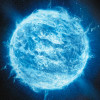
RIKEN Research: Modeling the insides of a neutron star
Astrophysicists at RIKEN have developed an improved model for the interior structure of neutron stars. It agrees well with obser-vations, and, unlike previous models, it can be extended to consider what happens when two neutron stars merge.Neutron stars are incred-ibly dense, being the size of a medium asteroid but having masses similar to that of the Sun. They have an onion-like structure, which theorists have been trying to model. To read more, please see the related link.
-
2020-06-26
Research News
"Minute-to-minute weather prediction" article on RIKEN RESEARCH by Takemasa Miyoshi
Deputy Program Director at iTHEMS Dr. Takemasa Miyoshi talks about weather simulation using a supercomputer "Fugaku".
-
2020-06-25
Research News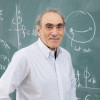
A Black Hole’s Lunch Provides a Treat for Astronomers
iTHEMS Senior visiting scientist, Gordon Baym, gave a comment on GW190814 in New York Times.
-
2020-06-25
Research News
Is interdisciplinary research really the best way to tackle global challenges?
In this magazine article, various researchers include Dr. Tetsuo Hatsuda advocate for issues and opinions about interdisciplinary research. Please read it at the related link.
-
2020-06-25
Research News
Neutron star particles go under the LHC microscope
This article form Symmetry contains an interview with Dr. Tetsuo Hatsuda, Program Director at iTHEMS . Please enjoy.
-
2020-05-18
Research News
Mesoscopic spin transport between strongly interacting Fermi gases
Understanding of physical properties for quantum many-body systems with strong interparticle interactions is one of key issues common to various subfields of physics. Such systems range from high-Tc superconductors in solid-state physics to neutron star interiors in nuclear physics. Among these systems, ultracold atoms are very pure atomic gases whose interactions can be tuned by optical and/or magnetic fields. The ultracold atoms thus provide an ideal platform to simulate the strongly interacting systems. Recently, quantum transport of ultracold atoms have been actively investigated in order to clarify how strong interactions affect their nonequilibrium properties. Motivated by this experimental situation, we theoretically study spin transport for strongly interacting Fermi gases in two-terminal setup where the gases in left and right reservoirs are connected via a narrow construction (see Figure). In particular, the spin current for normal Fermi gases in two situations are focused on. The first situation is the pseudogap region, where both gases have small spin polarizations and are above the superfluid transition temperature. In this case, spin-up and spin-down fermions in each reservoir prefer to form pairs (so-called preformed Cooper pairs) due to the strong attractive interaction. Because of this pairing effect, the spin degrees of freedom tend to be frozen and thus the spin current is largely suppressed. The other situation is a region where the gases in the left and right reservoirs have large spin polarizations with opposite sign. In this case, minority-spin particles behave as the “Fermi polarons,” which are quasiparticles consisting of minority-spin particles dressed by majority-spin ones. The appearance of the Fermi polarons results in the increase of the minority densities of states, leading to the enhancement of the spin current. Our results suggest that the spin transport measurement becomes a sensitive probe to experimentally examine pseudogap and polaron phenomena, which have attracted much attention not only in atomic physics but also in solid-state physics.
-
2020-03-19
Research News
RIKEN Research: Merger between two stars led to iconic supernova -- Simulations suggest that two stars came together to form a blue supergiant, which subsequently exploded
A supernova in a nearby galaxy may have originated from an explosion of a blue supergiant formed by the merger of two stars, simulations by RIKEN astrophysicists suggest1. The asymmetric nature of this explosion may provide hints for where to look for the elusive neutron star birthed in this stellar cataclysm. A core-collapse supernova occurs when the core of a massive star can no longer withstand its own gravity. The core collapses in on itself, triggering a violent explosion that blasts away the star’s outer layers, leaving behind a neutron star or black hole. In 1987, astronomers saw a star explode in the Large Magellanic Cloud, one of our galaxy’s closest neighbors. Since then, scientists have intensively studied the aftermath of this supernova, known as SN 1987A, to understand the nature of the progenitor star and its fate. The progenitor of this type of supernova is usually a red supergiant, but observations have shown that SN 1987A was caused by a compact blue supergiant. “It has been a mystery why the progenitor star was a blue supergiant,” says Masaomi Ono at the RIKEN Astrophysical Big Bang Laboratory.
75 news
